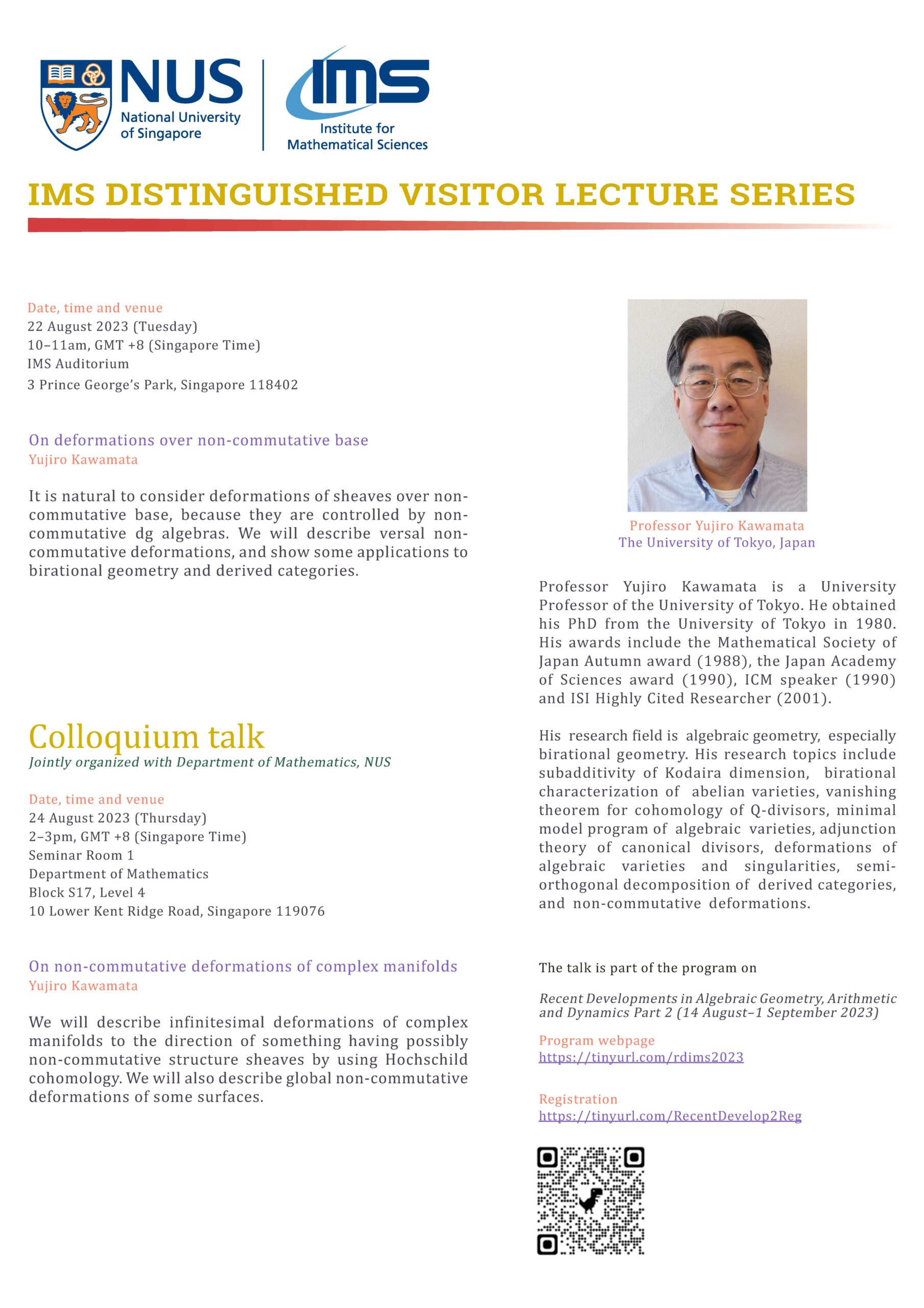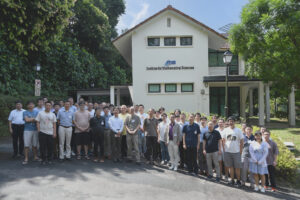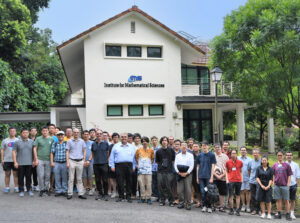Organizing Committee
Co-chairs
- Tien Cuong Dinh (National University of Singapore)
- Hélène Esnault (Freie Universität Berlin)
- Keiji Oguiso (University of Tokyo)
- De-Qi Zhang (National University of Singapore)
Contact Information
General Enquiries: Ims-enquiry(AT)nus.edu.sg
Scientific Aspects Enquiries: matzdq(AT)nus.edu.sg
Overview
Part One of the program was held in Year 2021.
Algebraic Geometry, Arithmetic and Dynamics constitute very large research domains with strong interactions.
The main themes of the program are as follows:
(1) Classification of higher dimensional algebraic varieties and algebraic dynamical systems, including the Minimal Model Program (MMP) and equivariant MMP
(2) Group actions on varieties
(3) Holomorphic dynamics in higher dimensions and related topics, e.g. foliation theory, algebraic flows
(4) Number theoretical dynamical systems
Algebraic Geometry and Dynamics
From the algebro-geometry side, the Hodge theory and the Minimal Model Program offer powerful tools. Since the work of Deligne-Nakamura-Ueno [Ue75] in 1975, we know that the automorphisms of the variety preserve the Iitaka-Kodaira fibration. The result constitutes a first step in the classification problem and suggests the use of natural fibrations to study the dynamics of (semi-) groups. This fundamental result has been extended to non-invertible systems by Nakayama-Zhang [NZ09] in 2009. Other fibrations induced by Albanese maps and Maximal Rationally Connectedness fibrations are also invariant. They allow ones to focus the classification problem on the three classes of varieties: Rationally connected varieties Campana [Cam92], Kollar-Miyaoka-Mori [KMM92], Varieties of general type, and Varieties with vanishing Kodaira dimension and irregularity.
A fundamental work by Gromov [Gr77] in 1977 relates some dynamical invariants of a holomorphic self-map, such as dynamical degrees and topological entropy with other algebraic invariants defined by the action of the map on the Hodge cohomology group. This important discovery has been established in its full generality for meromorphic self-maps in the work of Dinh-Sibony [DS05] in 2005 and for maps with invariant fibrations in the work by Dinh-Nguyen-Truong [DNT12] in 2012.
As mentioned above, the minimal model program, initiated by Mori, offers another powerful tool to the classification problem. The idea is to run an equivariant minimal model program in order to reduce the system to the case where the phase space is a uniruled variety (with a Fano fibration) or a minimal variety, i.e., with a semi-positive canonical bundle. Recent spectacular developments of the minimal model program, including fundamental works by Birkar-Cascini-Hacon-McKernan [BCHM06] in 2006 and Siu [Siu08] in 2008, will allow to have significant progress in the equivariant program (e.g. Meng-Zhang [MS17]).
From the dynamical side, positive closed currents were introduced by Sibony in complex dynamics in 1990 and their study has become an extremely powerful tool in the field. They have been introduced and used earlier in complex geometry as generalized complex varieties by Lelong, Oka, Siu, Demailly, Berndtsson among others. In the dynamical setting, they allow one to compute in the Hodge cohomology group, and get strong ergodic and explicit equi-distribution properties despite that the system may not be uniformly hyperbolic. The theory of positive closed currents is still a fast growing research direction and one expects many interactions with dynamics and algebraic geometry in the coming years. Only few mathematicians can master the techniques from dynamics, pluripotential theory and algebraic geometry. One of the aims of this program is to offer them an opportunity to learn the techniques they have not known yet and to work together on some concrete questions.
It is worthy mentioning that algebraic dynamical systems may allow to solve problems from algebraic geometry which do not originally involve dynamics. For instance, a recent remarkable result by Lesieutre [Le18] in 2018 (see also Dinh-Oguiso [DO19]) uses automorphism actions in order to get complex algebraic varieties with infinitely many real forms and also a result by Cantat-Oguiso [CO15] using complex dynamics to obtain information on the movable cone conjecture for Calabi-Yau manifolds of special type. One can also expect that dynamics could be useful in the study of K3 surfaces, Calabi-Yau manifolds and their moduli.
Arithmetic and Dynamics
There are at least four research topics which involve arithmetic and the theory of dynamical systems that we would like to consider in this program. Consider a dynamical system on an algebraic variety which is defined over a number field. The orbits of points or subvarieties can be studied using techniques from both the number theory and dynamics. The main tools are invariant height functions. They are the number theoretic counterparts of dynamical Green functions which are potentials of invariant currents. They allow to construct invariant measures and study equidistribution problems, as pluripotential theory does for systems defined over complex numbers field. This research direction is developed by Szpiro, Ullmo, Zhang and also Silverman, Kawaguchi, and Chambert-Loir among others; see Szpiro-Ullmo-Zhang [SUZ97], Zhang [Zsw06]. Strong similarities between results and techniques of the arithmetic nature and those of the analytic nature suggest deep interactions between arithmetic and holomorphic dynamics. We will continue to focus the program on this topic.
Another direction is the p-adic dynamics which is developed by Baker, DeMarco, Rivera-Letelier, Favre, and Jonsson among others. Although analytic tools have been introduced in this topic, and Yoccoz expected strong interactions between p-adic and complex dynamics, more efforts will be needed to develop the theory in higher dimensions.
In positive characteristic, the dynamics cannot be studied directly on the phase space which may be finite but the action on cohomology poses many challenging questions. The absence of a good notion of the positivity, which exists in the complex setting, is a great source of difficulties. Some important works have been recently done by Esnault-Srinivas [ES], Esnault-Oguiso [EO], and Tuyen [Tu16]. We aim to better understand the situation and focus discussions on possible new tools and techniques. This may lead to interesting applications in Hodge p-adic theory.
Finally, we are also considering the so-called algebraic flow which is the trace of a complex algebraic set in a symmetric domain and the distribution of its image in a compact/arithmetic quotient. The topic is well illustrated by the famous Ax-Lindemann-Weierstrass theorem Ax [Ax72], Baker’s works on algebraic dependence of complex numbers and recent Ullmo-Yafaev’s works Ullmo-Yafaev [UY17], Ullmo-Yafaev [UY18]. Notice that recently, the o-minimal theory has been introduced in the field with several applications by Pila-Zannier [PZ] and other people. On the other hand, techniques from complex analysis such as positive closed currents should be useful. However, the communication between people from this topic and complex geometry is still very limited. Our program will contribute towards developing such potential collaborations.
Relevant Bibliography
1) [Ax72] Ax, J., Some topics in differential algebraic geometry. I. Analytic subgroups of algebraic groups. Amer. J. Math. 94 (1972), 1195-1204.
2) [BCHM06] Birkar, Caucher Cascini, Paolo; Hacon, Christopher D.; McKernan, Jame, Existence of minimal models for varieties of log general type. J. Amer. Math. Soc. 23 (2010), no. 2, 405–468, arXiv:math/0610203v2
3) [Cam92] Campana, F., Connexité rationnelle des variétés de Fano, Ann. Sci. École Norm. Sup. (4) 25 (1992), no. 5, 539–545.
4) Cantat S. and Oguiso K., Birational automorphism groups and the movable cone theorem for Calabi-Yau manifolds of Wehler type via universal Coxeter groups, Amer. J. Math. 137 (2015) 1013–1044.
5) [DO19] Dinh, T.-C and Oguiso, K., A surface with discrete and non-finitely generated automorphism group, Duke Math. J. (2019), to appear.
6) [DS05] Dinh, T.-C.; Sibony N., Une borne supérieure pour l’entropie topologique d’une application rationnelle. Ann. of Math. (2) 161 (2005), no. 3, 1637–1644.
7) [DNT12] Dinh, T.-C., Nguyen, V. –A. and Truong, T. T., On the dynamical degrees of meromorphic maps preserving a fibration, Communications in Contemporary MathematicsVol. 14, No. 06, 1250042 (2012), arXiv:1108.4792
8) [EO] Esnault, H. and Oguiso, K., Non-liftability of automorphism groups of a K3 surface in positive characteristic, Math. Ann. 363 (2015) 1187–1206.
9) [EOY] Esnault, H., Oguiso, K. and Yu, X., Automorphisms of elliptic K3 surfaces and Salem numbers of maximal degree, Algebraic Geometry 3 (2016) 496–507.
10) [ES] H. Esnault and V. Srinivas, Algebraic versus topological entropy for surfaces over finite fields, Osaka J. Math. 50 (2013), no.3, 827-846.
11) [GHS03] Graber, Tom; Harris, Joe; Starr, Jason, Families of rationally connected varieties. J. Amer. Math. Soc. 16 (2003), no. 1, 57–67.
12) [Gr77] Gromov, Mikhaïl, On the entropy of holomorphic maps, Enseign. Math. (2) 49 (2003), no. 3-4, 217–235. (SUNNY preprent 1977)
13) [KMM92] Kollár, János; Miyaoka, Yoichi; Mori, Shigefumi, Rational connectedness and boundedness of Fano manifolds. J. Differential Geom. 36 (1992), no. 3, 765–779.
14) [Le18] Lesieutre, J., A projective variety with discrete non-finitely generated automorphism group, Invent. math. April 2018, Volume 212, Issue 1, pp 189–211.
15) [MZ17] Meng, Sheng and Zhang, De-Qi, Building blocks of polarized endomorphisms of normal projective varieties, Advances in Mathematics, 325 (2018), 243 – 273
16) [Nak10] Nakayama, Noboru, Intersection sheaves over normal schemes. J. Math. Soc. Japan 62 (2010), no. 2, 487–595.
17) [NZ09] Nakayama, Noboru; Zhang, De-Qi, Building blocks of étale endomorphisms of complex projective manifolds. Proc. Lond. Math. Soc. (3) 99 (2009), no. 3, 725–756.
18) [PZ08] Pila, J., Zannier U., Rational points in periodic analytic sets and the Manin-Mumford conjecture. Atti Accad. Naz. Lincei Rend. Lincei Mat. Appl. 19 (2008), no. 2, 149-162.
19) [Re87] Reid, Miles, The moduli space of 3-folds with K = 0 may nevertheless be irreducible. Math. Ann. 278 (1987), no. 1-4, 329–334.
20) [Siu08] Siu, Y.-T., Finite Generation of Canonical Ring by Analytic Method, Science in China Series A: Mathematics, April 2008, Volume 51, Issue 4, pp 481–502, arXiv:0803.2454
21) [SUZ97] Szpiro, L.; Ullmo, E.; Zhang, S. Équirépartition des petits points. Invent. Math. 127 (1997), no. 2, 337–347.
22) [Tu16] Tuyen Trung Truong, Relative dynamical degrees of correspondences over a field of arbitrary characteristic. J. Reine Angew. Math. (to appear), arXiv:1605.05049
23) [Ue75] Ueno, Kenji, Classification theory of algebraic varieties and compact complex spaces. Notes written in collaboration with P. Cherenack. Lecture Notes in Mathematics, Vol. 439. Springer-Verlag, Berlin-New York, 1975. xix+278 pp.
24) [UY17] Ullmo E., Yafaev A., O-minimal flows on abelian varieties. Q. J. Math. 68 (2017), no. 2, 359-367.
25) [UY18] Ullmo E., Yafaev A., Algebraic flows on abelian varieties. J. reine und angewandte Mathematik, Volume 2018, Issue 741, Pages 47–66
26) [Zdq09] Zhang, De-Qi, Dynamics of automorphisms on projective complex manifolds, Journal of Differential Geometry, 82 (2009) 691 – 722.
27) [Zdq10] Zhang, De-Qi, Polarized endomorphisms of uniruled varieties, Compositio Mathematica, Volume 146, Issue 01, January 2010, pp 145 – 168.
28) [Zsw06] Zhang, Shou-Wu, Distributions in Algebraic Dynamics. Surveys in differential geometry, Vol. X, 381–430, Int. Press, Somerville, MA, 2006.
Activities
| Date | Abstract | |
|---|---|---|
| Week 1: Seminars and Informal Discussions | 14–18 Aug 2023 | View |
| Week 2: Conference on Recent Developments in Algebraic Geometry, Arithmetic and Dynamics | 21–25 Aug 2023 | View |
| Week 3: Workshop on Complex Dynamics and Geometry | 28–31 Aug 2023 | View |
| Informal discussions | 1 Sep 2023 | N/A |
Venue
IMS Auditorium for all other dates
17, 24 and 28 August 2023 afternoon:
Department of Mathematics
Seminar room 04-06
National University of Singapore
S17, Level 4, 10 Lower Kent Ridge Road Singapore 119076



